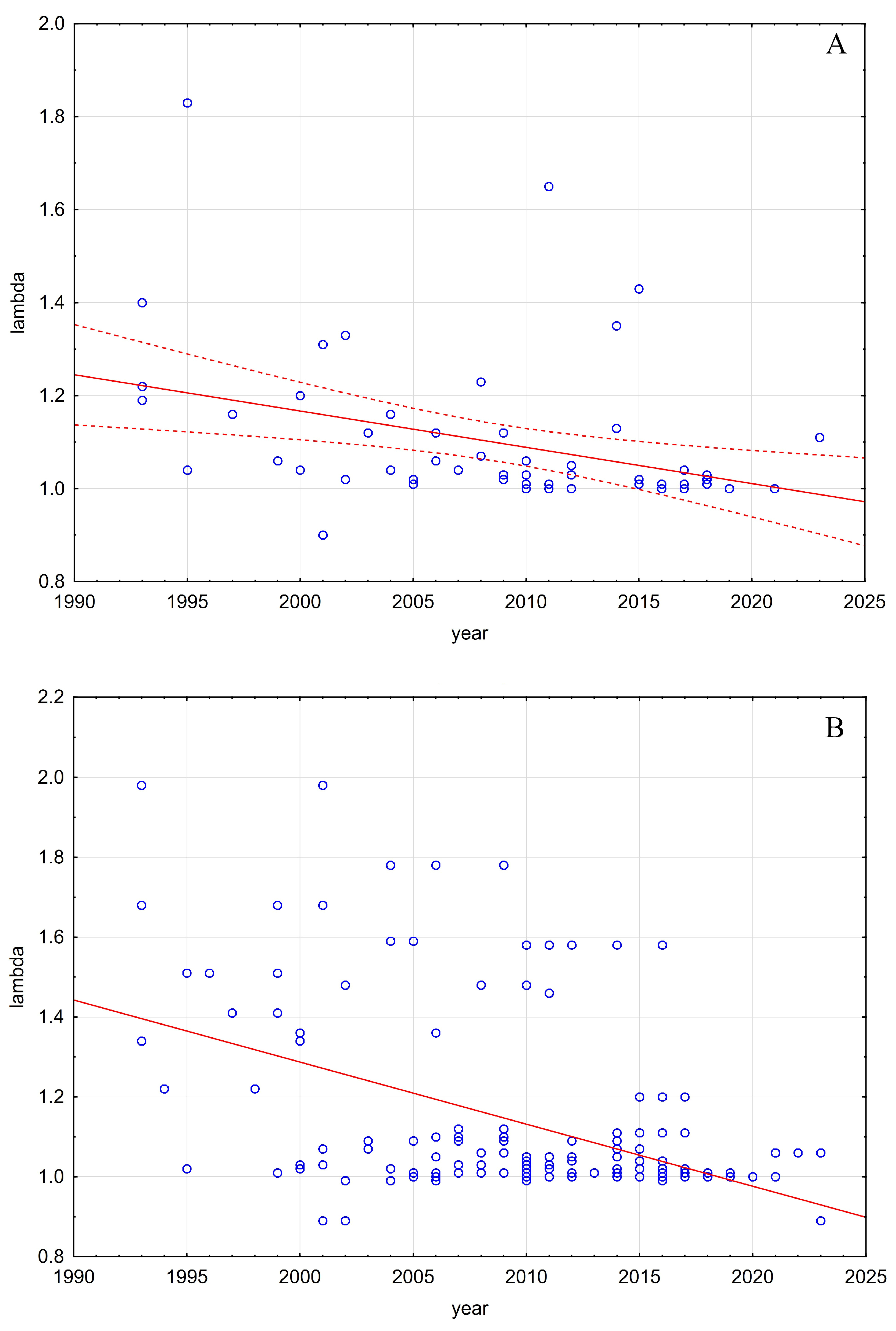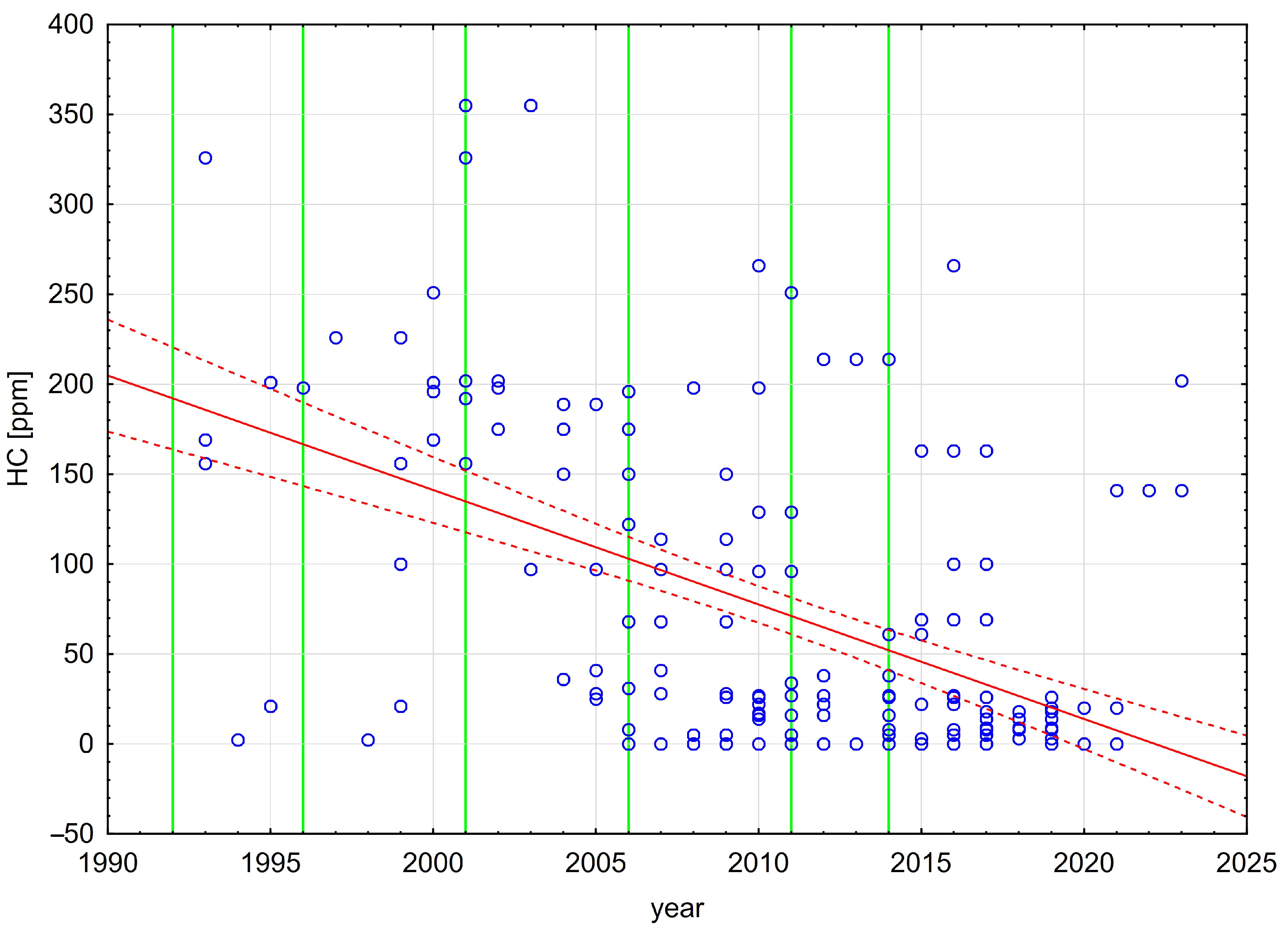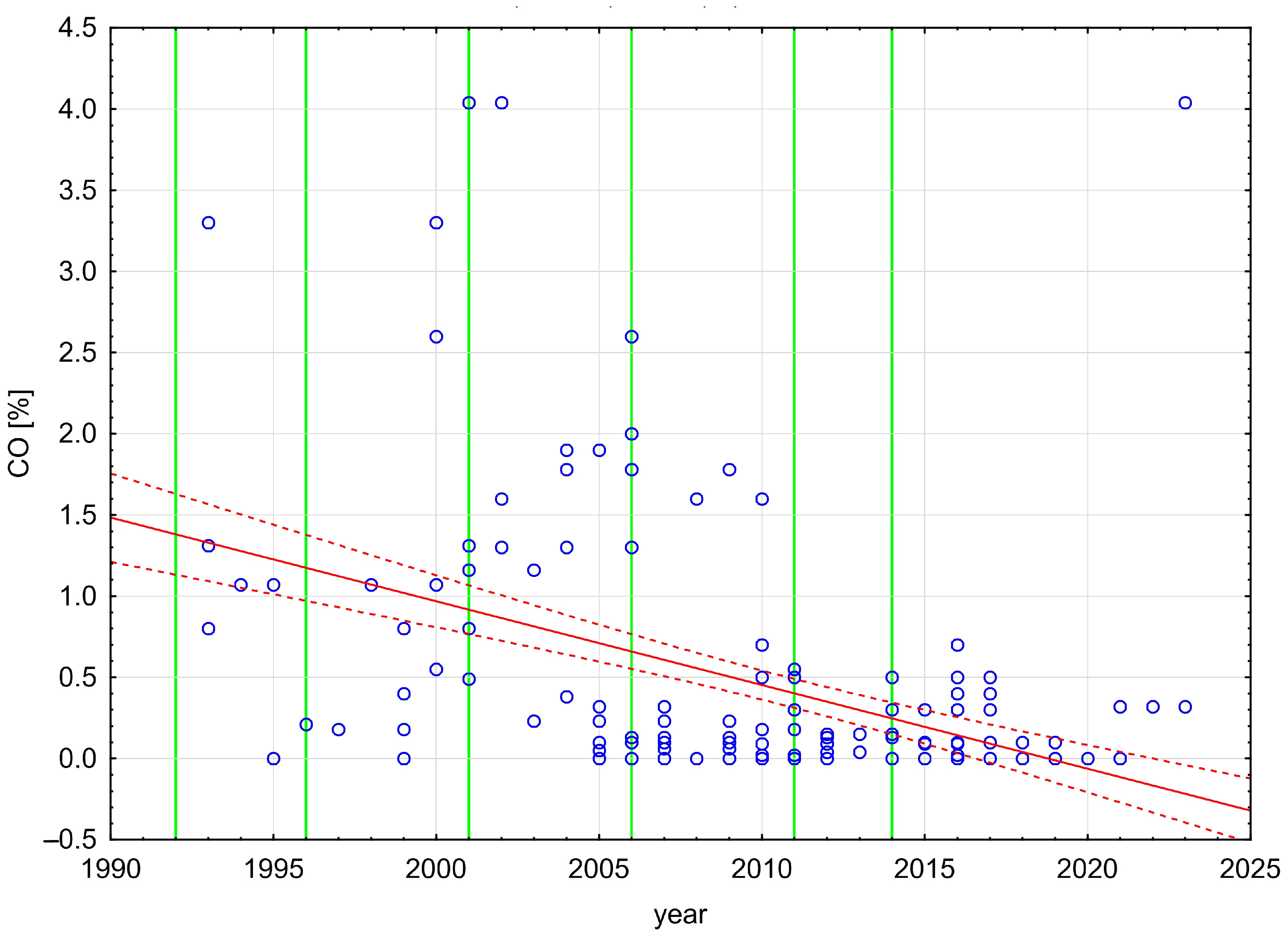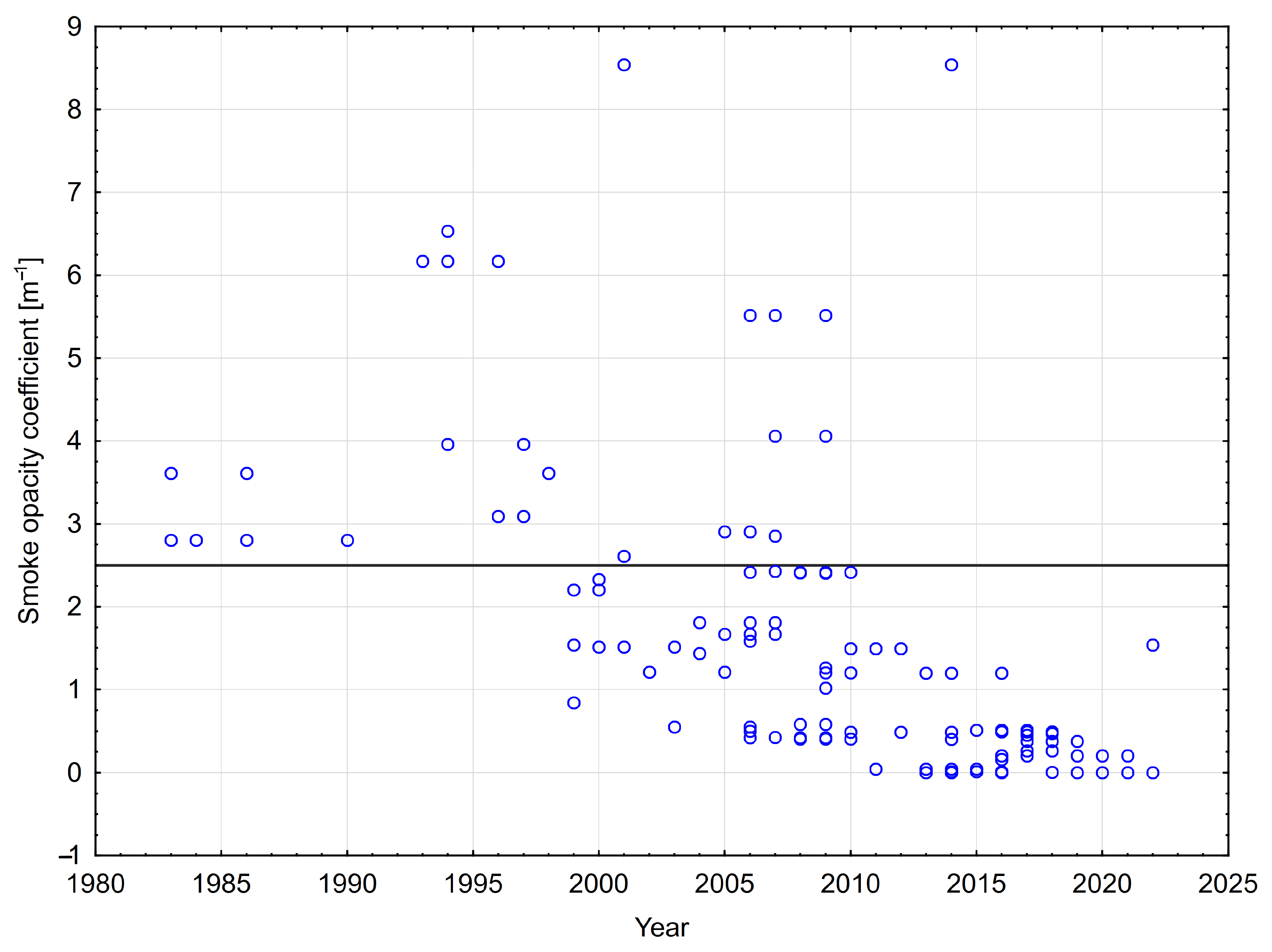The Analysis of Exhaust Composition Serves as the Foundation of Sustainable Road Transport Development in the Context of Meeting Emission Standards
Abstract
1. Introduction
2. The Vehicle Diagnostic System and the Achievement of Climate Goals in Road Transport
- Assessment of the vehicle’s technical condition, which makes it possible to detect various faults and failures that can be repaired before the vehicle is put into operation;.
- Optimization of fuel combustion through service or repair actions;
- Detecting fraud and illegal activities in car mechanics, such as removing the diesel particulate filter (DPF), modifying or removing the catalytic converter, or disabling the AdBlue/SCR system, among others;
- Raising environmental awareness among road users and promoting sustainable development in transportation;
- Conducting a real-world, rather than manufacturer-declared, assessment of emissions from individual power units, along with monitoring their degradation over time.
- PM10—a mixture of suspended solid particles in the air with a diameter of less than 10 μm;
- PM2.5—fine dust containing particles with a diameter of less than 2.5 μm,
3. Materials and Methods
- A written request to the Vehicle Inspection Station to provide the measurements taken on randomly selected vehicles;
- Collection of measurement values recorded on paper;
- Preparation of the analysis of the obtained measurements in a descriptive form;
- Preparation of a graphical analysis of the obtained measurements.
- Microsoft Excel 2023 for archiving data collected at the diagnostic station, conducting ongoing analyses, and preparing simple data presentations;
- Statistica v12 software for advanced statistical analyses, using analytical tools from the Six Sigma methodology, determining correlations between variables, and creating graphs with extended statistical analysis (e.g., 2D scatter plots);
- A SUN company absorption smoke meter for measuring car exhaust smoke;
- A CAPELEC CAP 320 exhaust gas analyzer for measuring exhaust gas composition and air excess ratio.
4. Results
4.1. Results of the Studies for Gasoline-Powered Vehicles
- Carbon monoxide (CO);
- Carbon dioxide (CO2);
- Hydrocarbons (HC).
- λ—mixture composition factor—dimensionless;
- —mass of air in the fuel–air mixture [kg];
- —mass of fuel in the fuel–air mixture [kg];
- —theoretical mass of air needed to burn 1 kg of fuel—is 14.7 [kg] of air [72].
- λ = 1—means that in the fuel–air mixture there is exactly as much oxygen as needed to burn the fuel, it is referred to as a stoichiometric composition;
- λ > 1—means that in the fuel–air mixture there is more oxygen than is needed to burn the fuel, so some of the oxygen will not be used in the combustion process; it is referred to as a lean mixture (implied in fuel);
- λ < 1—means that the fuel–air mixture contains less oxygen than is needed to burn the fuel; it is referred to as a rich mixture (implied to be rich in fuel).
4.2. Results of the Research for Vehicles Equipped with a Diesel Engine
5. Discussion
6. Conclusions
Author Contributions
Funding
Institutional Review Board Statement
Informed Consent Statement
Data Availability Statement
Conflicts of Interest
References
- Ciuła, J.; Wiewiórska, I.; Banaś, M.; Pająk, T.; Szewczyk, P. Balance and Energy Use of Biogas in Poland: Prospects and Directions of Development for the Circular Economy. Energies 2023, 16, 3910. [Google Scholar] [CrossRef]
- Kochanek, A.; Ciuła, J.; Generowicz, A.; Mitryasova, O.; Jasińska, A.; Jurkowski, S.; Kwaśnicki, P. The Analysis of Geospatial Factors Necessary for the Planning, Design, and Construction of Agricultural Biogas Plants in the Context of Sustainable Development. Energies 2024, 17, 5619. [Google Scholar] [CrossRef]
- Zwolińska, N.; Basta, E. Emissions of Gases and Dust into the Air as a Result of the Conversion of Landfill Gas into Electricity and Heat in a Cogeneration Plant. Rocz. Ochr. Sr. 2024, 26, 94–105. [Google Scholar] [CrossRef]
- Kowalski, S.; Opoka, K.; Ciuła, J. Analysis of the end-of-life the front suspension beam of a vehicle. Eksploat. Niezawodn.-Maint. Reliab. 2022, 24, 446–454. [Google Scholar] [CrossRef]
- Gaska, K.; Generowicz, A.; Lobur, M.; Jaworski, N.; Ciuła, J.; Mzyk, T. Optimization of Biological Wastewater Treatment Process by Hierarchical Adaptive Control. In Proceedings of the IEEE XVth International Conference on the Perspective Technologies and Methods in MEMS Design (MEMSTECH), Polyana, Ukraine, 22–26 May 2019; pp. 119–122. [Google Scholar] [CrossRef]
- Kochanek, A.; Kobylarczyk, S. The Analysis of the Main Geospatial Factors Using Geoinformation Programs Required for the Planning, Design and Construction of a Photovoltaic Power Plant. J. Ecol. Eng. 2024, 25, 49–65. [Google Scholar] [CrossRef] [PubMed]
- Kwaśnicki, P.; Augustowski, D.; Generowicz, A.; Kochanek, A. Influence of Ti Layers on the Efficiency of Solar Cells and the Reduction of Heat Transfer in Building-Integrated Photovoltaics. Energies 2024, 17, 5327. [Google Scholar] [CrossRef]
- Gaska, K.; Generowicz, A.; Ocłoń, P.; Stelmach, S. Location of the waste incineration plant with particular emphasis on the environmental criteria. J. Clean. Prod. 2021, 303, 126887. [Google Scholar] [CrossRef]
- Ciuła, J.; Generowicz, A.; Gaska, K.; Gronba-Chyła, A. Efficiency Analysis of the Generation of Energy in a Biogas CHP System and its Management in a Waste Landfill—Case Study. J. Ecol. Eng. 2022, 23, 143–156. [Google Scholar] [CrossRef]
- Bombiak, E.; Marciniuk-Kluska, A. Socially Responsible Human Resource Management as a Concept of Fostering Sustainable Organization-Building: Experiences of Young Polish Companies. Sustainability 2019, 11, 1044. [Google Scholar] [CrossRef]
- Sedovs, E.; Volkova, T. Sustainability: Is It a Strategic Management Research Fashion? Sustainability 2024, 16, 7434. [Google Scholar] [CrossRef]
- Wereda, W.; Zacłona, T. Shaping the image as a management instrument in the contemporary enterprise. Sci. Pap. Silesian Univ. Technol. Organ. Manag. Ser. 2020, 2020, 597–611. [Google Scholar] [CrossRef]
- Cizmaș, E.; Feder, E.-S.; Maticiuc, M.-D.; Vlad-Anghel, S. Team Management, Diversity, and Performance as Key Influencing Factors of Organizational Sustainable Performance. Sustainability 2020, 12, 7414. [Google Scholar] [CrossRef]
- Tavo, K.; Rasmus, R. The Role of Planning in Management: Strategies to Achieve Organizational Success. Sharia Oikon. Law J. 2024, 2, 106–115. [Google Scholar] [CrossRef]
- Schraeder, M.; Self, D.R.; Jordan, M.H.; Portis, R. The Functions of Management as Mechanisms for Fostering Interpersonal Trust. Adv. Bus. Res. 2014, 5, 50–62. [Google Scholar]
- Sakib, N.; Bakibillah, A.S.M.; Susilawati, S.; Kamal, M.A.S.; Yamada, K. Eco-Friendly Smart Car Parking Management System with Enhanced Sustainability. Sustainability 2024, 16, 4145. [Google Scholar] [CrossRef]
- Gulc, A.; Budna, K. Classification of Smart and Sustainable Urban Mobility. Energies 2024, 17, 2148. [Google Scholar] [CrossRef]
- Zając, P. Silniki Pojazdów Samochodowych. Budowa, Obsługa, Diagnostyka i Naprawa, 1st ed.; WKŁ: Warszawa, Poland, 2018; pp. 7–70. [Google Scholar]
- Jiang, Y.; Ding, D.; Dong, Z.; Liu, S.; Chang, X.; Zheng, H.; Xing, J.; Wang, S. Extreme Emission Reduction Requirements for China to Achieve World Health Organization Global Air Quality Guidelines. Environ. Sci. 2023, 57, 4424–4433. [Google Scholar] [CrossRef]
- Siedlecki, M.; Szymlet, N.; Sokolnicka, B. Influence of the Particulate Filter Use in the Spark Ignition Engine Vehicle on the Exhaust Emission in Real Driving Emission Test. J. Ecol. Eng. 2020, 21, 120–127. [Google Scholar] [CrossRef]
- Kijewski, J. Silniki Spalinowe; WSiP: Warsaw, Poland, 1998; pp. 10–45. [Google Scholar]
- Ciupek, B.; Brodzik, Ł.; Semkło, Ł.; Prokopowicz, W.; Sielicki, P. Analysis of the Environmental Parameters of the GTM 400 Turbojet Engine During the Co-Combustion of JET A-1 Jet Oil with Hydrogen. J. Ecol. Eng. 2024, 25, 205–211. [Google Scholar] [CrossRef]
- Rashdan, M.; Zubi, M.; Okour, M. Effect of Using New Technology Vehicles on the World’s Environment and Petroleum Resources. J. Ecol. Eng. 2019, 20, 16–24. [Google Scholar] [CrossRef]
- Imran, M.; Saleh, F. The Influence of Using Biodiesel Prepared from Cresson Oil on Emissions and Performance of CI Engines. J. Ecol. Eng. 2024, 25, 84–98. [Google Scholar] [CrossRef] [PubMed]
- Rymaniak, Ł.; Ziętara, B.; Szymlet, N.; Kołodziejek, D. Use of Toxicity Indexes in Reference to Carbon Dioxide for a Vehicle Equipped with a Two-Stroke Engine Without an Exhaust Aftertreatment System. J. Ecol. Eng. 2023, 24, 228–236. [Google Scholar] [CrossRef] [PubMed]
- Nakamura, M.; Yokota, K.; Ozawa, M. Automated Anomaly Detection and Causal Analysis for Civil Aviation Using QAR Data. Appl. Sci. 2025, 15, 2250. [Google Scholar] [CrossRef]
- Markowski, M.; Stanik, Z. Naprawa Zespołów i Podzespołów Pojazdów Samochodowych; Nowa Era: Warsaw, Poland, 2015; pp. 25–30. [Google Scholar]
- Czechlowski, M. Effect of Diesel Fuel Temperature on the Nitrogen Oxides Emission from a Compression-Ignition Engine. J. Ecol. Eng. 2020, 21, 164–170. [Google Scholar] [CrossRef]
- Xu, M.; Weng, Z.; Xie, Y.; Chen, B. Environmental and health co-benefits of vehicle emission control policies in Hubei, China. Transp. Res. Part D Transp. Environ. 2023, 120, 103773. [Google Scholar] [CrossRef]
- Rymaniak, Ł.; Mąka, M.; Szymlet, N.; Kamińska, M.; Kęska, A. Measurement of Exhaust Emissions from a Two-wheeler—An Experimental Validation of the Remote-Sensing Method. J. Ecol. Eng. 2023, 24, 60–71. [Google Scholar] [CrossRef]
- Ghazal, O. Reducing Diesel Engine Emission Using Reactivity Controlled Approach. J. Ecol. Eng. 2018, 19, 94–103. [Google Scholar] [CrossRef]
- Trzensik, E.; Światłoń, M. The impact of implementing EURO 5 and EURO 6 exhaust emission standards on the automotive industry, in terms of implementing new technologies and increasing vehicle operating costs. Zesz. Naukowe. Transp./Politech. Śl. 2019, 72, 75–81. [Google Scholar]
- Janczura, J.; Kochanek, A. Automotive Diagnostics Technical Tests of Vehicles on the Example of Selected Vehicle Inspection Stations; Academy of Applied Sciences in Nowy Sacz: Nowy Sącz, Poland, 2023. (In Polish) [Google Scholar]
- Kaylin, L.; Yoann, B.; Dallmann, T.; Tietge, U.; Pniewska, I.; Rintanen, I. Assessment of the Actual Emission of Vehicles in Warsaw; TRUE: Warsaw, Poland, 2022; pp. 1–15. Available online: https://www.trueinitiative.org/media/792226/true-warsaw-report-en.pdf (accessed on 30 January 2025).
- Babangida, A.; Szemes, P.T. Dynamic Modeling and Control Strategy Optimization of a Volkswagen Crafter Hybrid Electrified Powertrain. Energies 2024, 17, 4721. [Google Scholar] [CrossRef]
- Ruetten, O.; Pischinger, S.; Kupper, C.; Weinowski, R.; Gian, D.; Ignatov, D.; Betton, W.; Bahn, M. Catalyst Aging Method for Future Emissions Standard Requirements; SAE Technical Paper; SAE International: Warrendale, PA, USA, 2010. [Google Scholar] [CrossRef]
- Czerczak, S.; Szymczak, W.; Lebrecht, G.; Hanke, W. Diesel engine exhaust. Documentation of proposed occupational exposure limit values. Podstawy I Metod. Oceny Sr. Pract. 2005, 3, 89–133. [Google Scholar]
- Radsak, D. Reduction of nitrogen oxide emissions in power boilers as a necessity to meet European emission standards. Pozn. Univ. Technol. Acad. J. Electr. Eng. 2017, 90, 33–345. [Google Scholar] [CrossRef]
- Kordylewski, W. Spalanie i Paliwa; Oficyna Wydawnicza Politechniki Wrocławska: Wrocław, Poland, 1999; pp. 67–74. [Google Scholar]
- Kaczmarczyk, K. Concept of a nitrogen oxide reduction system with a flameproof combustion engine. Masz. Górnicze 2015, 33, 23–28. [Google Scholar]
- Bieniek, A.; Graba, M.; Lechowicz, A. Adaptive control of the exhaust gas recirculation system with a view to reducing harmful emissions for a classic CI engine. Inżynieria Rol. 2011, 15, 73–80. [Google Scholar]
- Li, X.; Song, H.; Zhai, S.; Lu, S.; Kong, Y.; Xia, H.; Zhao, H. Particulate matter pollution in Chinese cities: Spatiotemporal changes and their relationship with meteorological conditions (2015–2017). Environ. Pollut. 2019, 246, 11–18. [Google Scholar] [CrossRef]
- Dziubak, S. Intake air pollution from internal combustion engines of motor vehicles. Biul. WAT 2021, 70, 35–72. [Google Scholar] [CrossRef]
- Sala, S.; Zinko, I. Wybrane problemy zanieczyszczeń powietrza. Rocz. Świętokrz. Ser. B—Nauki Przyr. 2010, 31, 73–84. [Google Scholar]
- Juda-Rezler, K.; Toczko, B. Pyły Drobne w Atmosferze. Kompendium Wiedzy o Zanieczyszczeniu Powietrza Pyłem Zawieszonym w Polsce; Biblioteka Monitoringu Środowiska: Warsaw, Poland, 2016; pp. 67–80. [Google Scholar]
- Merkisz, J.; Pielecha, J.; Radzimirski, S. Emisja Zanieczyszczeń Motoryzacyjnych w Świecie Nowych Przepisów Unii Europejskiej; WKŁ: Warsaw, Poland, 2012; pp. 78–89. Available online: https://www.researchgate.net/publication/268221054_Emisja_zanieczyszczen_motoryzacyjnych_w_swietle_nowych_przepisow_Unii_Europejskiej (accessed on 31 January 2025).
- Pośniak, M.; Jankowska, E.; Szewczyńska, M.; Zapór, L.; Brochocka, A.; Pietrowski, P. Zagrożenia Spalinami Silników Diesla; Centralny Instytut Ochrony Pracy–Państwowy Instytut Badawczy: Warszawa, Poland, 2010; pp. 30–36. [Google Scholar]
- Myszkowski, S.; Układy Wylotowe Silników. Kompendium Praktycznej Wiedzy. 2009. Available online: https://issuu.com/intercars/docs/uklady_wylotowe_silnikow_po_korekci/1 (accessed on 17 July 2024).
- Bojnarowska, M. Zanieczyszczenia motoryzacyjne w środowisku. Technol. Eksploat. Syst. Transp. 2011, 10, 77–83. [Google Scholar]
- Polkowska, Ż.; Dubiella-Jackowska, A.; Zabiegała, B.; Namieśnik, J. Composition of pollutants released into the environment along roads with different vehicle traffic intensity. Ecol. Chem. Eng. 2007, 14, 315–338. [Google Scholar]
- Właśniewski, S. Wpływ emisji motoryzacyjnych na zawartość metali ciężkich w glebach położonych wzdłuż drogi krajowej Rzeszów-Łańcut. Zesz. Probl. Postępów Nauk. Rol. 2007, 520, 189–200. [Google Scholar]
- Wojtal, R. Zanieczyszczenie Powietrza w Miastach w Aspekcie Ruchu Samochodowego; Politechnika Krakowska: Kraków, Poland, 2018; pp. 112–120. [Google Scholar]
- Witaszek, M.; Witaszek, K. Porównanie Emisji Zanieczyszczeń Powietrza Przez Różne Gałęzie Transportu. 2014. Available online: https://repolis.bg.polsl.pl/Content/20411/Porownanie_emisji.pdf (accessed on 30 January 2025).
- Sabău-Popa, C.D.; Bele, A.M.; Negrea, A.; Coita, D.C.; Giurgiu, A. Do Energy Consumption and CO2 Emissions Significantly Influence Green Tax Levels in European Countries? Energies 2024, 17, 2186. [Google Scholar] [CrossRef]
- Jędrak, J. Impact of Particulate Air Pollution on Mortality: An Analysis for Krakow. 2017. (In Polish). Available online: https://yadda.icm.edu.pl/baztech/element/bwmeta1.element.baztech-cfca7758-fbb0-40cc-aad1-112f26e06465 (accessed on 30 January 2025).
- Jaroń, A.; Borucka, A. Spatiotemporal Changes in Air Pollution within the Studied Road Segment. Sustainability 2024, 16, 7292. [Google Scholar] [CrossRef]
- Merkisz, J. Ekologiczne Problemy Silników Spalinowych; Wydawnictwo Politechniki Poznańskiej: Poznań, Poland, 1999; pp. 1–10. [Google Scholar]
- Gronba-Chyła, A.; Generowicz, A. Municipal waste fraction below 10 mm and possibility of its use in ceramic building materials. Przemysł Chem. 2020, 99, 1318–1321. [Google Scholar] [CrossRef]
- Panaite, F.A.; Rus, C.; Leba, M.; Ionica, A.C.; Windisch, M. Enhancing Air-Quality Predictions on University Campues: A Machine—Learning Approach PM2.5 Forecasting at the University of Petrosani. Sustainability 2024, 16, 7854. [Google Scholar] [CrossRef]
- Krzeszowiak, J.; Pawlas, K. Particulate matter (PM2,5 and PM10), properties and epidemiological significance for respiratory and cardiovascular diseases. A review of the literature on the effects of short- and long-term exposure. Environ. Med. 2018, 21, 7–13. [Google Scholar] [CrossRef]
- Theakston, F. Air Quality Guidelines for Europe; WHO Regional Publications: Copenhagen, Dania, 2000; pp. 220–230. [Google Scholar]
- Anderson, J.; Thundiyil, J.; Stolbach, A. Clearing the Air: A Review of the Effects of Particulate Matter Air Pollution on Human Health. Natl. Cent. Biotechnol. Inf. 2012, 8, 166–175. [Google Scholar] [CrossRef] [PubMed]
- Giechaskiel, B.; Melas, A.; Martini, G.; Dilara, P. Overview of Vehicle Exhaust Particle Number Regulations. Processes 2021, 9, 2216. [Google Scholar] [CrossRef]
- Regulation of the Minister of Economy of December 7, 2007 on the Requirements to be Met by Automotive Exhaust Gas Analizers, and the Detailed Scope of Checks Performed During Legal Metrological Control of These Measuring Instruments, Dz.U. 2007 nr 241 Poz. 1765. (In Polish). Available online: https://isap.sejm.gov.pl/isap.nsf/download.xsp/WDU20072411765/O/D20071765.pdf (accessed on 30 January 2025).
- Regulation of the Minister of Development of June 2, 2016 on Requirements for Measuring Instruments, Dz.U. 2016 Poz. 815. (In Polish). Available online: https://isap.sejm.gov.pl/isap.nsf/download.xsp/WDU20160000815/O/D20160815.pdf (accessed on 30 January 2025).
- ISO 11614; Reciprocating Internal Combustion Compression-Ignition Engines—Apparatus for Measurement of the Opacity and for Determination of the Light Absorption Coefficient of Exhaust Gas. ISO: Geneva, Switzerland, 1999.
- Regulation of the Minister of Climate and Environment of June 26, 2024 on Liquid Fuel Quality Standards Dz.U. 2024, poz. 1018. (In Polish). Available online: https://isap.sejm.gov.pl/isap.nsf/download.xsp/WDU20240001018/O/D20241018.pdf (accessed on 30 January 2025).
- Available online: https://www.orlen.pl/pl/dla-biznesu/produkty/paliwa/benzyna/benzyna-bezolowiowa-95 (accessed on 30 January 2025).
- Regulation of the Minister of Climate and Environment of 26 June 2024 on Methods for Testing the Quality of Liquid Fuels Dz.U. z dnia 17 lipca 2024 r., poz. 1058. (In Polish). Available online: https://isap.sejm.gov.pl/isap.nsf/download.xsp/WDU20240001058/O/D20241058.pdf (accessed on 30 January 2025).
- PN-EN 590; Fuels for Internal Combustion Engines-Diesel Fuels-Requirements and Test Methods. Polish Committee for Standardization: Warsaw, Poland, 2022. (In Polish)
- Available online: https://www.orlen.pl/pl/dla-biznesu/produkty/paliwa/oleje-napedowe/ekodiesel-ultra (accessed on 30 January 2025).
- Cieślik, W.; Borowski, P.; Pielecha, I.; Bueschke, W.; Czajka, J.; Wisłocki, K. Systemy recyrkulacji spalin we współczesnych konstrukcjach silnikowych. Logistyka 2014, 3, 1118–1127. [Google Scholar]
- Regulation of the Minister of Transport and Maritime Economy of 7 September 1999 on the Scope and Manner of Conducting Technical Tests of Vehicles and Specimens of Documents Used in This Process. Dz.U. 1999, nr 81 poz. 917. (In Polish). Available online: https://isap.sejm.gov.pl/isap.nsf/download.xsp/WDU19990810917/O/D19990917.pdf (accessed on 30 January 2025).
- Fang, J.; Meng, Z.W.; Li, J.; Pu, Y.F.; Du, Y.H.; Li, J.S.; Jin, Z.X.; Chen, C.; Chase, G.G. The influence of ash on soot deposition and regeneration processes in the diesel filter. Appl. Therm. Eng. 2017, 124, 633–640. [Google Scholar] [CrossRef]
- Regulation of the European Parliament and of the Council of the European Union, 19 April 2023, Amending Regulation (EU) 2019/631 with Regard to Strengthening CO2 Emission Standards for New Passenger Cars and for New Light Commercial Vehicles in Line with the European Union’s More Ambitious Climate Targets. Euro-European Union, 2019/631. (In Polish). Available online: https://eur-lex.europa.eu/eli/reg/2023/851/oj/eng (accessed on 30 January 2025).
- Regulation (EU) 2019/1242 of the European Parliament and of the Council of 20 June 2019 Setting CO2 Emission Standards for New Heavy-Duty Vehicles and Amending Regulations (EC) No 595/2009 and (EU) 2018/956 of the European Parliament and of the Council and Council Directive 96/53/EC. (In Polish). Available online: https://eur-lex.europa.eu/legal-content/pl/TXT/?uri=CELEX%3A32019R1242 (accessed on 30 January 2025).
- Directive 70/220/EEC; The Approximation of the Laws of the Member States Relating to Measures to Be Taken Against Air Pollution by Emissions from Motor Vehicles. Council of the European Union: Brussel, Belgium, 1991.
- Directive 94/12/EC; Relating to Measures to be Taken Against Air Pollution by Emissions from Motor Vehicles and Amending Directive 70/220/EEC. Council of the European Union: Brussel, Belgium, 1994.
- Directive 98/69/EC; Measures to be Taken Against Air Pollution by Emissions from Motor Vehicles—Derogating National Provision Advancing the Lowering of the Community Limit on Emissions of Particulate Matter Produced by Certain New Diesel-Powered Vehicles. Council of the European Union: Brussel, Belgium, 1998.
- Directive 2002/80/EC; Adapting to Technical Progress Council Directive 70/220/EEC Relating to Measures to Be Taken Against Air Pollution by Emissions from Motor Vehicles. Council of the European Union: Brussel, Belgium, 2002.
- Commission Implementing Regulation (EU) 715/2007; Type Approval of Motor Vehicles with Respect to Emissions from Light Passenger and Commercial Vehicles (Euro 5 and Euro 6) and on Access to Vehicle Repair and Maintenance Information. Council of the European Union: Brussel, Belgium, 2007.
- Commission Implementing Regulation (EU) 459/2012; Regards Emissions from Light Passenger and Commercial Vehicles (Euro 6). Council of the European Union: Brussel, Belgium, 2012.
- Regulation of the European Parliament and of the Council of 17 April 2019 setting CO2 Emission Standards for New Passenger Cars and New Light Commercial Vehicles and Repealing Regulations (EC) No 443/2009 and (EU) No 510/2011. (In Polish). Available online: https://eur-lex.europa.eu/legal-content/pl/LSU/?uri=oj:JOL_2019_111_R_0003 (accessed on 30 January 2025).
- Announcement of the Minister of Infrastructure of 29 February 2024 on the Announcement of the Unified Text of the Decree of the Minister of Infrastructure on the Technical Conditions of Vehicles and the Scope of Their Necessary Equipment. Journal of Laws. 2024 Item 502. (In Polish). Available online: https://isap.sejm.gov.pl/isap.nsf/download.xsp/WDU20240000502/O/D20240502.pdf (accessed on 30 January 2025).
- Available online: https://polskialarmsmogowy.pl/2024/10/trwa-wyscig-o-czyste-powietrze-najnowszy-ranking-smogowych-rekordzistow/ (accessed on 28 February 2025).
- Regulation (EU) 2024/1257; Type-Approval of Motor Vehicles and Engines and of Systems, Components and Separate Technical Units Intended for Such Vehicles, with Respect to Their Emissions and Battery Durability (Euro 7). Council of the European Union: Brussel, Belgium, 2012.






| Parameter | Unit | Range | |
|---|---|---|---|
| Minimum | Maximum | ||
| Research octane number (RON) | – | 95 | – |
| Motor octane number (MON) | – | 85 | – |
| Lead content | mg/L | – | 5 |
| Density at 15 °C | kg/m3 | 720 | 775 |
| Content of hydrocarbons type: | % (v/v) | ||
| - olefinic | – | 18 | |
| - aromatic | – | 35 | |
| Benzene content | % (v/v) | – | 1 |
| Oxygen content | % (m/m) | – | 3.7 |
| Content of oxygen compounds: | % (v/v) | ||
| - methanol | – | 3 | |
| - ethyl alcohol | – | 10 | |
| - isopropyl alcohol | – | 12 | |
| - isobutyl alcohol | – | 15 | |
| - tert-butyl alcohol | – | 15 | |
| - ethers (with 5 or more carbon atoms) | – | 22 | |
| - other organic compounds containing oxygen | – | 15 | |
| Parameter | Unit | Range |
|---|---|---|
| Cetane number | - | min. 51.0 |
| Cetane index | - | min. 46.0 |
| Residue from coking | % (m/m) | max. 0.30 |
| in 10% distillation residue | ||
| Remains after cremation | % (m/m) | max. 0.010 |
| Water content | mg/kg | max. 200 |
| % (m/m) | max. 0.020 | |
| Content of solid pollutants | mg/kg | max. 24 |
| Fractional composition for species B, D, F | ||
| at a temperature of 250 °C, it distills | % (v/v) | <65.0 |
| at a temperature of 350 °C, it distills | % (v/v) | min. 85.0 |
| Content of methyl esters | % (v/v) | max. 7.0 |
| Residue after distillation | % (v/v) | max. 2 |
Disclaimer/Publisher’s Note: The statements, opinions and data contained in all publications are solely those of the individual author(s) and contributor(s) and not of MDPI and/or the editor(s). MDPI and/or the editor(s) disclaim responsibility for any injury to people or property resulting from any ideas, methods, instructions or products referred to in the content. |
© 2025 by the authors. Licensee MDPI, Basel, Switzerland. This article is an open access article distributed under the terms and conditions of the Creative Commons Attribution (CC BY) license (https://creativecommons.org/licenses/by/4.0/).
Share and Cite
Kochanek, A.; Janczura, J.; Jurkowski, S.; Zacłona, T.; Gronba-Chyła, A.; Kwaśnicki, P. The Analysis of Exhaust Composition Serves as the Foundation of Sustainable Road Transport Development in the Context of Meeting Emission Standards. Sustainability 2025, 17, 3420. https://doi.org/10.3390/su17083420
Kochanek A, Janczura J, Jurkowski S, Zacłona T, Gronba-Chyła A, Kwaśnicki P. The Analysis of Exhaust Composition Serves as the Foundation of Sustainable Road Transport Development in the Context of Meeting Emission Standards. Sustainability. 2025; 17(8):3420. https://doi.org/10.3390/su17083420
Chicago/Turabian StyleKochanek, Anna, Józef Janczura, Sławomir Jurkowski, Tomasz Zacłona, Anna Gronba-Chyła, and Paweł Kwaśnicki. 2025. "The Analysis of Exhaust Composition Serves as the Foundation of Sustainable Road Transport Development in the Context of Meeting Emission Standards" Sustainability 17, no. 8: 3420. https://doi.org/10.3390/su17083420
APA StyleKochanek, A., Janczura, J., Jurkowski, S., Zacłona, T., Gronba-Chyła, A., & Kwaśnicki, P. (2025). The Analysis of Exhaust Composition Serves as the Foundation of Sustainable Road Transport Development in the Context of Meeting Emission Standards. Sustainability, 17(8), 3420. https://doi.org/10.3390/su17083420










